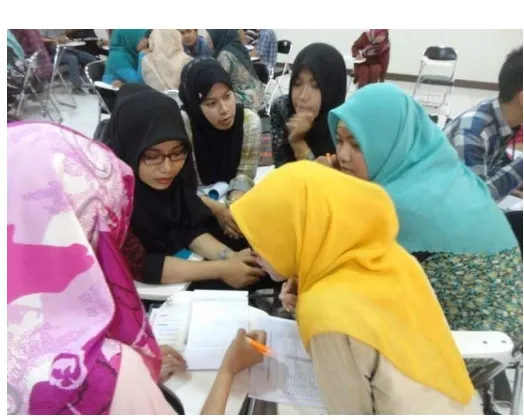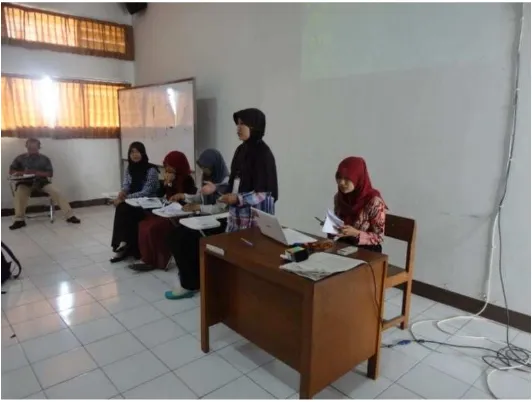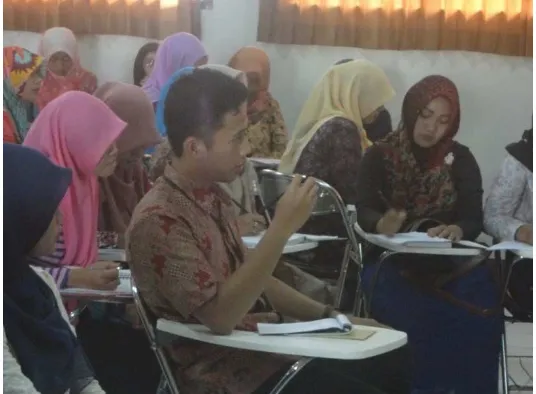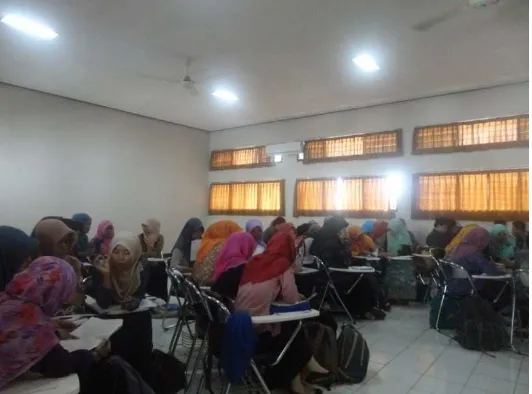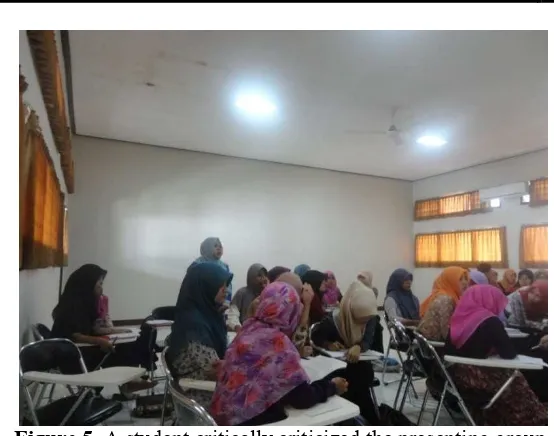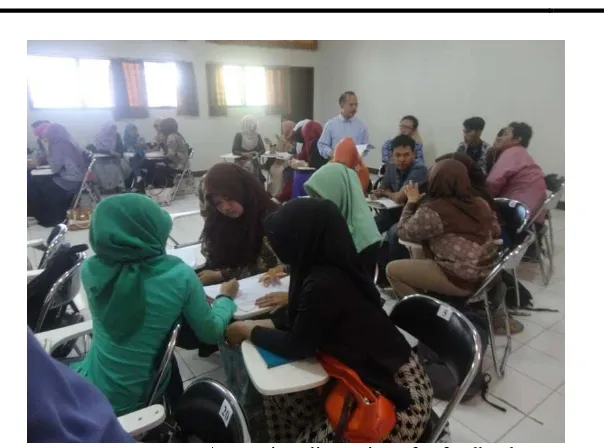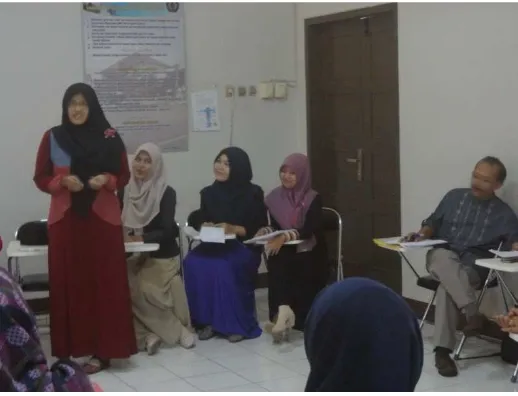The 2nd International Conference on Science, Technology, and Humanity ISSN: 2477-3328 Faculty of Teacher Training and Education, Central Java, Indonesia
Abstract
This study aimed to improve the tertiary students’ participation in the research class. It was conducted
in the framework of a Lesson Study. Data were collected through observation, questionnaire, and testing. The data were analysed using descriptive statistics. In the study, a colleague served as the classroom observer and assisted the data analysis. The writer, who was the lecturer of Research in Language Teaching course, acted as the model teacher. The research indicated that the Group Investigation
teaching model successfully improved the students’ participation in the research class.
Keywords: Tertiary students, participation, research class, Group Investigation.
1.
Introduction
A teacher-centered learning has been considered to provide disadvantages to both the teachers and students. Beside the students do not actively participate in the learning process, the teacher has to release a lot of energy. The writer as a teacher at Research in Language Teaching course at the ELT Department is used to face this situation in the classroom.
The research course has undergone several methodological changes, i.e. from lecturing and Q/A session to paper writing assignment and presentation. From the beginning, the students were very passive in the class and the learning outcomes were relatively low. In the advance within the few semesters, however, the paper content, presentation quality, and material mastery were still unsatisfactory. In addition, the students were stagnantly passive and low achievers.
In fact, research course requires high reasoning. Material such as why a certain type of research is adopted as an approach to solve the problem under investigation and how a sample is taken with the least possible error, are definitely not a simple matter. Therefore in many higher educational institutions, writing academic papers has been a “monster”, especially in terms of methodology. Subiyantoro and Sulistyo (2006) pointed out that students’ inadequte insights in the research methodology have led to many troubles in the implementation during their fieldwork. A few works (eg. Mulyatiningsih, 2004 and Waluyati, 2001) supported this issue, many students encountered problems in the writing process for the research project, primarily in the aspect of methodology.
The 2nd International Conference on Science, Technology, and Humanity ISSN: 2477-3328
constructing their own knowledge at the early stage of planning, both in determining a topic and learning it through an investigation. Thus, the GI could develop students’ autonomous reasoning skill.
Since a research course is naturally associated with investigation, applying the GI for teaching in the course will be appropriately. It was indicated by the enthusiasm of the students to participate in the study. However, the students’ enthusiasm could mean a strong desire to be involved in learning.
↑osniadou, in Indonesia’s National Commission for UNESCO in corporation with General Director of Primary and Secondary Education (2002), required the presence of involvement in learning. In the meanwhile, students’ involvement will develop if the teacher: (1) avoids a situation in which the students become a passive listener in a long duration; (2) provides direct activities, such as experiment, observation, project-based, etc. to the students; (3) encourages the students to have role and participation in classroom discussions; (4) manages time for school visits to museums and technological garden; (5) permits students to partly control their own learning process, meaning that the teacher allows them to make a decision of what and how to learn; and (6) helps the students to set learning goals in accordance with their interests and future aspirations. .
A teacher in the GI is just a consultant and/or a friendly critic (Joyce and Weil, 1972). The teacher prepares, organizes, monitors, and evaluates learning. By doing so, students are actively involved in constructing their knowledge. In relation with the concept of “Group Investigation” and the existing condition, teachers and researchers had a slight different perception in relation with the classroom implementation. According to Rusman (2013) the implementation of the GI in classrooms covers: 1) identifying a topic and organize students into groups. Students review sources of information, choose a topic, and organize feedback, etc., 2) planning learning tasks. Students within their group discuss what to investigate, how to do it,
etc., 3) conducting an investigation. Students search for information, analyze it, draw a conclusion, etc., 4) preparing a report. The groups prepare essential things in the projects, plan to report, etc., 5) making a presentation of the final report. Presentation is made to be presented to the whole class, and 6) evaluating. The students share feedbacks, affective experiences, teachers and students collaboration in evaluating learning and assessment are directed to evaluate the concept mastery and critical thinking skill.
This research aimed to improve the student participation in Research in Language Teaching 2 course at semester 6 in the ELT Department of Universitas Muhammadiyah Purwokerto by applying the Group Investigation method.
2.
Methods
This research was conducted within the frame of a Lesson Study. It aimed to study the students’ learning behavior. It was conducted by a group of teachers one of whom served as the model teacher while the others were doing observations when the teaching and learning process were conducted. The model teacher was the teacher at Research in Language Teaching 2 class.
Data were collected through questionnaires, observation, and testing. Questionnaires were intended to find out the students’ perceptions and opinions before and after the application of GI in the research class. Observation was done to collect data on the students’ behaviors. Testing was administered to determine the students’ learning outcomes.
The 2nd International Conference on Science, Technology, and Humanity ISSN: 2477-3328
discussed by the group in order to determine the potential teaching and learning process. Data obtained from the test were analyzed by using descriptive statistics.
3.
Results and Discussion
3.1. Results
3.1.1 Pre-intervention
Before the GI was applied, some orientations were given to the students. Questionnaires were also distributed to find out the students’ initial perception. From the close questionnaires, it was found out that the students’ response to the instruction in the previous semester was sufficiently good with the average of 69.7%.
It was also found out that the students gave negative responses to the teaching media (24.4%), lecture content (22.2%), and learning activity/task (15.5%). The open questionnaires indicated that several students (27.7%) needed opportunities to practice their knowledge in the form of fieldwork, as a student originally wrote in the first languageμ “the research material should refer to paper writing research and [we should be] given a research simulation as in the graduate paper writing...”. Others criticized the teacher personally.
a. Lesson 1
The application of the GI began on March 27, 2015. It was commenced by questions related with the students’ experiences in attending the previous semester research class and their difficulties. Surprisingly, several students spoke up in English. The teacher then told the students about the initial reflection dealing with the previous semester research course as well as the result of questionnaires administered in the pre-intervention period. There was a similar opinion, especially in the involvement of the students in the class. The students were also recalled that the scoring system was emphasized on student participation.
The 2nd International Conference on Science, Technology, and Humanity ISSN: 2477-3328
Figure 1. A Group planned the assigned task.
Twenty-five minutes were allocated for student discussion on the task planning. The teacher monitored the activity and provided required assistance. The students seemed to work seriously.
After the discussion, one or two groups were given a chance to share their discussion result. Two groups were ready. The teacher recorded the performance and gave feedback. For example, a school principal was chosen as a source person in the field of survey research, which was a wrong target. The teacher, then, recommended they should meet the head of statistics office in town instead. The students were also instructed to relate any required information with research in the language teaching context.
At the end of this stage, the teacher invited the students to draw conclusions together. The students, in turn, tried to draw a conclusion in accordance with their perceptions. Before the class was dismissed, the teacher insisted that each group should create their information/knowledge from varied sources in the form of report. He also instructed each group for ready to present their initial progress report in the next lesson.
Soon after the class was over, the model teacher invited the colleagues to discuss the implementation of the method and to share feedbacks for the next lesson. Based on the discussion, the model teacher and colleagues agreed that the students were relatively active and they showed appreciation.
b. Lesson 2
Lesson 2 was started a few minutes behind the schedule. As soon as the teacher entered the classroom, the students appeared to be calm and slightly distress. This might be due to lack of preparation to present the previous assignment. After greeting the students, the teacher investigated if they had problems in gathering materials and writing a report for the presentation. Quickly, several students represented their groups to share experience. A student said his group had an appointment problem with the source person. Another student said the intended source person had refused to be interviewed. The teachers took notes on the obstacles and gave feedback.
The 2nd International Conference on Science, Technology, and Humanity ISSN: 2477-3328
only one appeared. It was likely that the other group did not come up because the members had not done the assignment yet. The teacher stated that the absent group had put the rest of the class at a disadvantage and, therefore, they deserved punishment at least in credit reduction.
The Survey Research group did not seem to be well-prepared in the presentation. It could be seen from the slow physical movement and less self-confidence in the presentation, except for the leader (wearing the group identity tag), while the other members was busy with other activities.
Figure 2. The “Survey Research” group made a presentation.
When the presentation was carried out, the students listened for it seriously. Unfortunately, however, the teacher had to impede the presentation since the presented material was too broad. The teacher decided to have a discussion with the presenting group instead. It seemed that the group failed to relate the developed material with the language teaching context. The teacher recalled that each group should relate the material with the language teaching, e.g. to be supported by the sample of factual problems or cases in language teaching.
When entering the Q/A session, a student criticized the presenting group in accordance to his group experience, i.e. the need to explore wider access instead of only on limited particular source. The teacher added that the group was not tough, as only the leader showed an adequate mastery of the material presented. In addition, critical comments from the teacher included the absence of eye-contact with the audience and the flat talk intonation due to the presenter’s concentration on the notes and the texts on slides.
Since no more students gave responses, the teacher invited the class to draw a conclusion. A few students raised hands, but they turned out to give feedback instead. The class was ended by suggesting that the group should improve the material and the technique of presentation. In addition, other groups should be prepared seriously for their presentation.
The 2nd International Conference on Science, Technology, and Humanity ISSN: 2477-3328
c. Lesson 3
At the beginning of this lesson, the students seemed to be in underpressured situation. Several students also came to the class late. After having them position themselves, the teacher gave them a chance to share their problems while completing the assignment. Two group leaders informed their group’s difficulties. The first student said that the source persons did not respond the questionnaire sent to them. The teacher suggested that they should interview the source person instead, as it was more flexible. The second student was persistent to go through a wrong plan that had been commented upon by the teacher in the previous lesson, i.e. to dig information of causal-comparative research from a secondary school teacher, that was finally in vain.
Subsequently, the teacher instructed that the presenting groups were the “Quasi -Experiment” research group. Overally, the impression of the core activity of this lesson remained the same as previous lesson, with only one presenting group came to the lesson. In addition, the presenting group did not seem to work cooperatively. The members had uneven performance during the session, only two of them showed an adequate mastery of the material. Nevertheless, both of them were free from any notes and slides. Nevertheless, the material presented was not comprehensive (centered around a certain aspect only), still conceptual (not backed up with sufficient illustration), and non specific (quasi-experiment was not discussed within the context of language teaching). Furthermore, part of the presentation was a mis-concept.
When Q/A session was opened, a student asked a few questions and addressed some qualified comments as well. Subsequently, the presenters counter-attacked him successfully.
Figure 3. Debates between audience and the presenting group.
The reasoning power of this student was incredible. His oral English proficiency was also excellent. This enabled a vivid discussion to take place between the student and two members of the presenting group. This probably made lesson 3 was different from the previous lessons.
The 2nd International Conference on Science, Technology, and Humanity ISSN: 2477-3328
characteristics, typical questions/problems, and adequate real sample) that should be referred to by groups in the next meeting and explained them one by one.
Before the class was ended, as usual, the students were invited to draw a conclusion. They looked reluctant to perform it, even the teacher should encourage more. The only student spoke up was the leader of the presenting group, even though this student just repeated after the teacher. The class was ended with a recommendation for a better next presentation and participation.
In the research group discussion, the teacher proposed a suggestion to give the audiences a chance to discuss within their own groups about the material and performance of the presenting group. This was meant to maximize the response. It was approved. The colleague suggested that the teacher should instruct the students to mention his/her name while raising hands. This was intended to encourage them to give responses and avoid the domination of better achievers.
d. Lesson 4
The causal-comparative research groups were assigned to present their works on this time occasion. Overally, the class condition was the same as the previous lesson. The only thing different was that the audience looked more focused and attentive when the presentation was carried out and active when the Q/A session was conducted. It might be due to the previous information that they were given chance to have their group discussion before the Q/A session. Nearly all students actively participated in the discussions and criticized the presenting groups for approximately 10 minutes.
Figure 4. The audience discussions before the Q/A session.
The 2nd International Conference on Science, Technology, and Humanity ISSN: 2477-3328
Figure 5. A student critically criticized the presenting group.
In response to the “attack” received, the leader of the presenting group addressed a qualified counter-attack. But, again, the performance imbalance among the group members was remained unchanged. In a group consisting of four to six members, only one or two showed an adequate mastery of the material.
Figure 6.A presenter addressed a “counter-attack”.
It indicated that the group-work was not optimal in preparing the session. The provision of each individual in giving responses could be regarded as a reflection of how the group had prepared themselves for a presentation. If each individual had participated enough, there would not have been understanding or information gap among the members.
The 2nd International Conference on Science, Technology, and Humanity ISSN: 2477-3328
e. Lesson 5
In this lesson, the students positioned themselves without any instruction. The teacher made a little joke just to reduce the tension by calling the groups in the classroom as delegates from different parts of the globe.
The teacher gave an opportunity to all students to share their problems while making preparation. However, none of the students took a chance. The teacher assumed that the students had found their way better at last. Therefore, he randomly chose the “Classroom Action Research” group to make presentation. This time, the teacher instructed the class that they would be given chance to prepare responses. They were also recalled to mention their name before they were allowed to give response. Overall, the presenting groups seemed more prepared than the previous ones. Both groups paid attention to each other’s presentation. Besides showing better interest in speaking up, they had more frequent eye-contact with the audiences as well.
Figure 7. Two presenting groups shared a good performance.
The 2nd International Conference on Science, Technology, and Humanity ISSN: 2477-3328
Figure 8. Pre-Q/A session discussions for feedback.
When Q/A session was begun, more students (between 6 and 7) raised hand. Two of them gave more than one responses. A student criticised and suggested that the presenters’ comment upon material from an article or research report, hence, it was something empirical instead of theoretical. The question was qualified. A student asked the maximum number of cycles in a classroom action research. Discussion created in this lesson was very serious, similar to the previous lesson. The difference was that in this session, more students get involved in the Q/A session and new “players” came up. Out of 7 (seven) students who got chance to deliver feedback, only 1 obtained score B, the rest deserved A.
From Q/A session, it was revealed that the presenting group had a misunderstanding. For example, a presenter stated that the role of a collaborator in a classroom action research was to sit for a classroom observation. This statement could be misleading, as the classroom observation is done only when a lesson is going on. A research collaborator to some extent shares responsibility within the group.
The 2nd International Conference on Science, Technology, and Humanity ISSN: 2477-3328
There was a problem in relation with the individual performance. The members of the presenting group had unevenly performance during the session, especially when giving response to the audiences. Among the 12 students who were the members of the presenting groups, grouponly three of them gave significant responses. It indicated that the groups’ preparation was not maximum. However, in overall, the student participation in the lesson had a high progress.
After a little feedback from the teacher, the lesson was ended. Soon after the class was over, a discussion with the colleague was held. From the discussion, it was agreed that entirely, the students’ participation in the class had improved. It was made possible by doing adjustment in the implementation of GI from lesson to lesson. In the discussion, the colleagues suggested that in the next lesson, the presenting groups would be given an opportunity to share their material for a moment in order to achieve well-organised presentation and to avoid an overlap. It was assumed that the next lesson would be the last and after that a quiz to assess the mastery of the learning material would be administered.
f. Lesson 6
In this lesson, the students seemed to get accustomed to the condition. They took a seat and mingled. The teacher asked if they still had problems in preparing the material for presentation. Only two of them raised hands. Having listened to while giving feedback to them, the teacher let the students sit with their group. As usual, they sat in circles. The teacher told the class that today’s presenting groups was “Correlational Study” groups. The teacher instructed the audiences to pay attention as the session for discussion was available later. Both groups were given opportunity to share for a while.
Entering the presentation time, in overall, both groups seemed to show adequate mastery of the material, less impression in having other activities, and in contrast, more attention to the students who had a presentation, as well as the absence of reliance on texts and slides.
Figure 10. One of the good presenting groups.
The 2nd International Conference on Science, Technology, and Humanity ISSN: 2477-3328
Figure 11.The students’ enthusiasm to give responses.
Some students seemed enthusiastic in giving response to the presentation. One of them was a new “face”. Both groups at the front gave “counter attack” to any “attack” from the audiences. However, as ever before, the members in the presenting groups did not distribute the performance evenly.
From the questionnaire administered at the end of the Lesson Study, several findings have emerged. First, in relation with randomized topic for group presentation (item no. 1) out of 16 sample students, 1γ gave positive response to the use of lottery. A student commentedμ “In my opinion, it is good, as it is the fairest way”. For presentation turn taking (item no. β), there were two opinions. Approximately 50% of the students stated that on the spot choice for the presenting groups was the appropriate step . A student wroteμ “... it encourages all groups to be ready for presentation”. The other 50% gave negative comments, such as to cause the tension in the class.
In relation with effectiveness (item no. 3), as many as 14 students gave positive responses. A student notedμ “.... more challenge to learn and master the material”. In the meanwhile, in regard with presentation intelligibility, five students stated they had not understood the other groups’ presentation. It was likely that most groups did not maximize the member participation in preparing the material and presentation.
Result of mid-term test indicated that the average score only reached 51.2. Around fifteen percent of the students achieved “Good” scores. The majority (7β.7%) of the students obtained scores considered as “moderate”. The rest, 1β.7%, were categorized to “Poor”. This means that, in overall, the students’ material mastery was still unsatisfactory. From the questionnaires, it can be explained that some students did not understand the other groups’ presentation due to the complexity. Observations also indicated the students’ shortage in preparation for the presentation, especially in the beginning. However, the problem has gradually disappeared.
3.2. Discussion
The 2nd International Conference on Science, Technology, and Humanity ISSN: 2477-3328
Problem in the use of power point and LCD projector as teaching media lied in the fact that slides were filled up with text, that implied limited mastery or presentation preparation– “hiding” behind slides. In the meanwhile, the absence of practical learning tasks such as field -work assignments were assumed to have led to an idea that the course was too much abstract, conceptual, and theoretical.
Learning/presentation material was gathered by the students by themselves from resource and reference books. In general, groups presented the material conceptually in the way they obtained it from the sources, thus, there were possibilities that it would be uneasy for other students to understand the material. As a consequence, students might sit listening to the presentation attentively. However, when Q/A session was begun, only one to three of them addressed low quality questions.
A few criticisms from students in the pre-intervention period were difficult to accept. While they criticised the scoring system, the teacher so far had adopted certain criteria when to assess and score to ensure objectivity, as agreed in prior to the teaching and learning process. The students had to submit papers on the first day before they made presentation, it was intended to reach objectivity in the assessment across groups of students, as well as to encourage them to get involved since the beginning of the process.
In conjunction to the aim of the study, i.e. to improve student participation in Research in Language Teaching 2 course, some findings had emerged.
a. The Information/Material Gathering
In Group Investigation, the students are expected to have a capacity to collect lesson information/material cooperatively with the group-mates. With initial orientation given by the teacher, the students searched for learning material in its widest possible accesses instead of only on limited reference books.
Before going deeper into the core of instruction in every lesson, the teacher used to give the students an opportunity to share their experience and problems in preparing and gathering the materials for presentation. At the beginning, several students took this opportunity. Several students reported that they had started collecting information by using the internet and interviewing the source persons. Since the teacher showed appreciation and gave necessary feedback, students did not seem to be doubtful and reluctant to share their problems.
Several students also complained that they had experienced obstruction in meeting up the source persons. Besides, several students seemed to make mistakes in determining the source persons. From those drawbacks, it could be inferred that the students’ information/learning material gathering activity was actual, even though it might be faulty to assume that the students had optimised the power of groupwork. However, it was obvious that from lesson to lesson, the number of students who reported their problems went down and none of the student had one.
b. The Preparation for Information/Material of Presentation
The 2nd International Conference on Science, Technology, and Humanity ISSN: 2477-3328
frequency to have eye-contact to audience was higher. It was also clearly seen that coverage of presentation material became more accurate and material mastery became more comprehensive.
It has shown that the presenting group was more serious in preparing presentation material as well as the presentation itself. Unfortunately, this condition was not balanced by the active participation among the members of presenting group.
c. The Students’ Participation
In the beginning of GI implementation, the audiences came, sit, listened to the presentation or had a conversation, and ask questions if there were any questions. Subsequently, it was decided that the audiences were not allowed to have a conversation during the presentation session. They were given opportunity to have a discussion for responses after the presentation. It seemed that this initiative was effective. The audiences paid attention, showed enthusiasm in following the presentations, made discussion for responses, and addressed varied responses. Since then, quite often, the audiences seemed to be more active to argue, criticise, and give suggest. However, at times, discussions led to endless debates due to the ignorance, misunderstanding, and/or misconcept either among the audience or with the presenting groups. In this case, the teacher assisted the process. Teacher involvement was just to help in directing and searching for a way out, without providing the material/information instantly.
d. The Students’ Opinion on the Teaching and Learning Process
The fact that the quality of Research in Language Teaching 2 teaching and learning process with the implementation of Group Investigation teaching model had improved the students’ participation was supported with the data obtained from questionnaires. Overall, the students supported the teaching model.
Out of the 5 (five) items only one item received a negative reaction. The reaction is related to the teacher’s on the spot determination toward the presenting groups. Fifty percent of the students disliked this ‘frontal procedure’. →hile they thought that it might be more constructive if the presentation task was assigned a week earlier. However, the teacher had another opinion. By ‘on the spot’ or frontal strategy, the teacher encouraged all groups to prepare themselves better and be ready for a presentation anytime.
Even though the learning outcome was unsatisfactory, in line with the initial aim of this study, i.e. to improve student participation in the teaching of Research in Language Teaching 2 course, in overall, this Lesson Study was a valuable experience.
4.
Conclusion and Suggestion
4.1. Conclusion
An assessment on the process, Research in Language Teaching 2 class with the implementation of GI teaching model had successfully improved the students’ participation. The findings that supported this idea were as follows. Firstly, the students’ material preparation
The 2nd International Conference on Science, Technology, and Humanity ISSN: 2477-3328
presentation session, dynamic group discussion prior to Q/A session for reaction to a presentation, and more varied reactions.
Quality of learning process was revealed in students’ voices. Overall, students had supported the teaching model applied in Research in Language Teaching 2 courses. Out of 5 (five) items, only 1 (one) received negative reaction from approximately a half of class participants. Reaction was related to the teacher’s on-the-spot determination toward the presenting groups. Meanwhile, examined from the learning outcome, test result indicated unsatisfactory gain. Student average score was only approx. 51.
In line with the aim of this Lesson Study, i.e. to improve student participation in Research in Language Teaching 2 class, it could be concluded that this Lesson Study was valuable experience.
4.2. Suggestion
Based on the research finding, it was recommended that GI teaching model should be adopted as an alternative on the research class in the university. Up to the end of the research, it was likely that unequal performance across presenting group members had been a persistent issue. For a future reference, it was necessary to consider smaller groups of 2 - 3 students. It is expected that the smaller number of member, the group will be more solid due to little/no chance of depending on other group-mates.
References
Gay, L. R. & Airasian, P. (2000). Educational Research: Competencies for Analysis and Application. Prentice-Hall, New Jersey.
Joyce, B. and Weil, M. (1972). Models of Teaching. Prentice-Hall, New Jersey.
Komisi Nasional Indonesia untuk UNESCO bekerjasama dengan Dirjen Dikdasmen Bagian Proyek Publikasi dan Sosialisasi Pendidikan. (2002). Seri Praktik Pendidikan: Untuk Guru, Pendidik, dan Orangtua dalam Rangka Meningkatkan Kualitas Sumberdaya Manusia. Akademi Pendidikan Internasional dan Biro Pendidikan Internasional UNESCO, Jakarta.
Mulyatiningsih, E. (2004). Diagnosis permasalahan mahasiswa yang mengalami krisis masa studi. Paedagogia: Jurnal Penelitian Pendidikan, 7.
Rusman. (2013). Model-Model Pembelajaran. Raja Grafindo Persada, Jakarta.
Subiyantoro, S. dan Sulistyo, E. T. (2006). Kendala-kendala yang dihadapi dalam menyelesaikan skripsi pada mahasiswa program seni rupa fkip uns surakarta.
Paedagogia: Jurnal Penelitian Pendidikan, 9.
